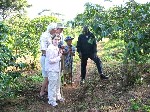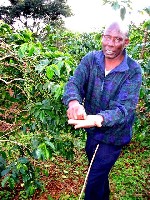Posted on Friday, July 6, 2007
Moses, the man of history, used a walking stick as did Moses, our guide at Gibb's Farm in Tanzania. He offered each of us a stick and I almost refused. I don't usually find one necessary. This time I was glad I took Moses at his offer!
We moved down the slope, part of the outer wall of Ngorongoro Crater next door to the Serengeti in Tanzania, East Africa. This is fantastic country. Geologically, it is the east edge of the Great Rift Valley -- millions of years old and extending from southern Turkey to Mozambique. Astronauts can see the Rift Valley from the moon! At a distant time in the far future, as the big Plates continue to shift, Africa east of the Rift will be separated from the mainland of Africa as a separate land mass! Historically, this immediate region has been farmed for over 2,000 years by Africans of the Iraqw Tribe who migrated south from Ethiopia and Yemen and who still dominate the area today. During the periods of colonialism, the Germans and then the British laid claim to the region. Neglected through the years of World Wars I and II, the 50 hectare farm was bought in 1948 by James Gibb, a British war veteran, who returned it to production. This farm is where we met Moses!
He knows the farm well because he has worked here all his life. He is of the Iraqw Tribe. He is proud and tall. His English is clear and distinctly British. At this mature stage of life, Moses walks slowly and with his stick scratches and probes the good, rich earth. He shows us elephant tracks and leads us to a small waterfall along the trail. His description of the farming operation reminded me of what might have been said of Westminster's Field Station when it was, indeed, a farm. Some of the crops were similar: corn, other grains and garden vegetables. The big difference is that much of Gibb's Farm is devoted to coffee! (And we have no elephants!)
We stopped at a coffee tree scarcely 10 feet tall. Moses told us that this tree was over 100 years old! Then he reached out and picked some red coffee berries for us and rubbed them to expose the coffee beans -- two "beans" inside each fruit. What he said next made my ears perk: "We take all the flesh of the coffee berry and use it because it is good. We compost it." Then he described how the beans, now separated from the flesh, are dried and stirred in the sun and shade, how they are roasted and ground to make the familiar brew. All of this happens at Gibb's Farm. I asked for more details on the composting. How is it done? What do they do with the compost? Is this what makes the soil at Gibb's Farm so rich? He gave me and fellow hikers in my group of ecotourists all the answers. They make piles of the coffee "flesh" and regularly stir it by hand with other wastes from farm and kitchen. Eventually all the compost is returned to the vegetable gardens and coffee fields. Nothing is wasted. Over years of this type of farming they have become 100 per cent "organic." They use no artificial fertilizers or pesticides. In the hike back and up the slope at Gibb's Farm I used the stick Moses had given me.
We spent the night in cottages at Gibb's Farm. In the morning we had breakfast before heading into the Serengeti to observe big game animals. (And the day after that we would glide over part of the Serengeti in a hot air balloon!) While drinking my rich, tasty, Gibb's Farm coffee and eating delicious melons and papaya grown at Gibb's Farm I couldn't help but wonder what would be going on that day in the compost rows eight time zones and over 7,000 miles away at Westminster's Field Station. Gibb's Farm and the Field Station, sometimes called the "Bio Farm," have a lot in common. I like both of them!
Clarence Harms, Director
Field Station

